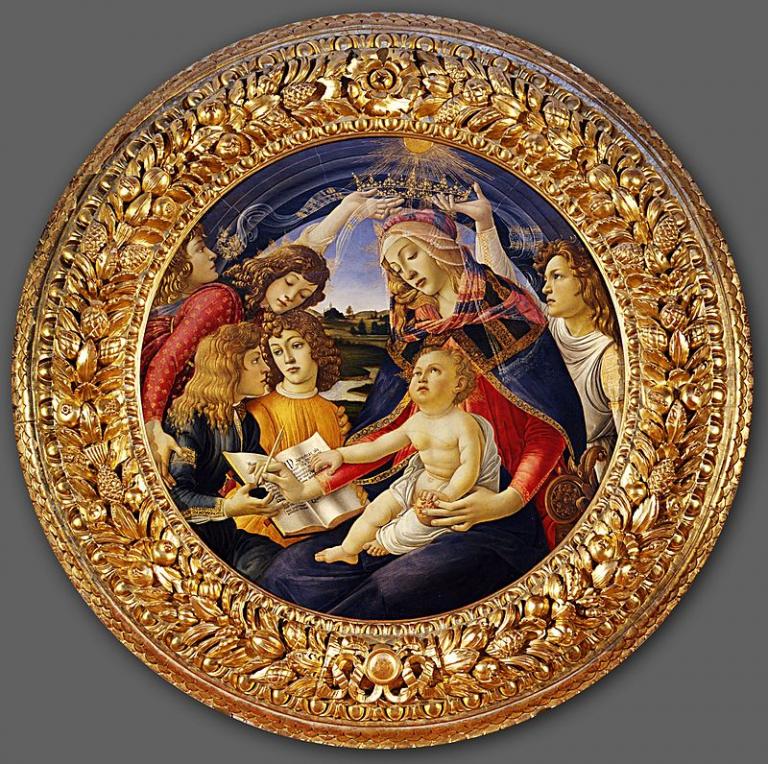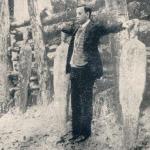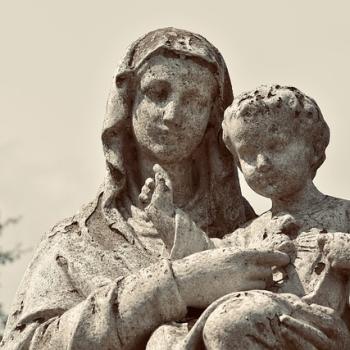
This image is one of my favorite paintings of the Virgin Mary.
Please, just admire it for a moment before we get into an art history lecture. I love her expression, the gracefulness of her pose, the sumptuous Renaissance dress, the solemn or bored angels, the sweetness of that chubby Baby Jesus. I like to imagine Our Lady looking just like this sometimes when I pray to her.
This painting is the “Magnificat Madonna,” by Sandro Botticelli, painted in 1481. Botticelli was a painter of the Florentine School in what is now Italy. He painted many gorgeous Madonnas with light skin and flowing blond hair like that. He’s also famous for his paintings of the pagan goddess Venus with light skin and flowing blond hair. He used the same model for both subjects, Venus and Mary, on purpose; you might say he viewed the Mother of God as a sort of fulfillment of what people loved in Venus.
I love seeing how people incorporate Our Lady into their own cultures and mythologies like that. They make images that don’t look a thing like her, to express their devotion, and that’s a wonderful part of Catholicism.
Oh, that’s right. In case you didn’t remember, the Virgin Mary isn’t European.
It’s so easy to forget that historical fact. European people have made images of Jesus and Mary as Europeans for centuries; they’ve become symbols of Europe and “Western culture.” But that’s not what they were when they walked among us on earth. They weren’t Western and certainly not European.
They saw Europeans from time to time, of course. The people from Europe were the conquerors, the foreigners who colonized their world and thought of their culture as dirty and degenerate. Italians, Romans, white people from what is now Italy, were the soldiers who occupied her country and prowled around it heavily armed, to make sure it didn’t escape their grasp. Imagine how she must have felt– how indigenous women in occupied countries have always felt when they were near the people who conquered them. She had been raised knowing that those conquering soldiers could do whatever they pleased to indigenous Jewish girls like her– anything at all that they wished, and they did. She surely knew people they had raped and tortured. Imagine the shudder as she went about her daily business. Imagine her fear as she raised her Son in Nazareth, a city occupied by the conquering race that nearly killed her precious Baby in a genocide, to prevent an uprising. Imagine how her heart shot into her throat if a Roman soldier walked too close to Joseph’s carpentry shop and glanced at the baby. Imagine how she felt when she lost Him in Jerusalem, and when she found Him again. Imagine what she was thinking, or trying not to think, as she watched Him preaching the Gospel in front of them.
Eventually, the Romans tortured Jesus to death.
Mary– Miriam, actually, and even that name as you read it in your head probably isn’t the exact pronunciation– Miriam was not European. She was a Jewish woman, but she didn’t look like the Ashkenazi Jewish people you might have met in Europe or the United States. She was a Jewish woman from what is now Palestine– one of the Semitic peoples of the Middle East like the Palestinians or the Bedouin. Her skin might have been any shade from olive tan to rich warm brown, but it wasn’t white. Her hair was deep brown or black. Her eyes were dark. Her clothing was not blue. Painting Mary’s veil in blue was a tradition that came out of European culture, when blue pigment was ground from real jewels and the most expensive paint. They painted her clothes in blue to honor her majesty. In real life she probably wore a lot of brown, light browns to reflect the sun, layers to let the air flow– this kept her cool in the daytime and warm on chilly desert nights. She veiled after she was married, not with a lace mantilla but with a woven scarf. She went barefoot or wore sandals. She didn’t wear tights, underpants, bras, corsets or other things that have been customary in modest European dress.
The language she spoke was not a language that you and I, if you are of European heritage, find normal. The language the Italians spoke over her head, and the alphabet they wrote in, were alien to her. I don’t know whether she ever learned to read or speak Latin at all, but it wasn’t her native language.
The culture to which she belonged was a culture that didn’t look like anyone whose frame of reference is Western European Christianity. They had festivals at different times than we do. They sang hymns we don’t sing. Their idea of boring everyday foods and treats for special occasions were strange to us, and the rituals that accompanied meals were not the same as ours. She washed her feet before dinner and said a prayer that sounded like “Barukh ata Adonai Eloheinu, melekh ha`olam…”
When she got pregnant, out of wedlock and under extraordinary circumstances, the cultural and religious taboos involved didn’t feel like the ones we of European heritage know. Her wedding to Saint Joseph didn’t involve tuxedos, a long white lace dress and a Baroque church. The advice and fretting she was subjected to from other women in the community probably wasn’t the advice and fretting you and I got when we were pregnant, if you’ve ever been pregnant. She swaddled her Son in swaddling cloths to prevent His bones from going crooked, because that was the folk wisdom of the day.
She sang Him lullabies that didn’t sound like the ones you and I grew up hearing. She raised Him in that strange culture with the strange language, she taught him manners and customs that aren’t ours, and she wove Him a seamless garment that isn’t like anything you and I see men wearing.
Eventually the Romans murdered Him.
He rose from the dead and ascended into Paradise.
The Romans began murdering His followers, but eventually, Christ conquered Rome. And from then on, the Italians acted as if they’d always been Christian, as if Christianity were something Italian. And from there, Christianity spread. It spread through Italy, where artists painted pagan figures like the Delphic Sybil on the walls of Catholic churches. It spread all over Africa where it had already begun; Christianity is considered one of the indigenous religions to Africa. It spread to Germany where they’ve celebrated the same Passion Play every ten years for centuries, performed in German by people who don’t look like Jesus or Mary. It spread to France, to England, to Ireland where my ancestors come from– my surname is Italian but that’s my husband’s fault. I’m of Celtic blood, not Italian. They say that Saint Patrick was the one who invented the Celtic Cross, by combining a Christian cross with a pagan “sun cross” that the Celts were already using.
Christianity spread to North and South America, where the Italians and the French and the English and so on all became the murderous conquerors of indigenous peoples– just as the Italians were over a thousand years earlier to the Jews in Palestine and to the early Christians. It spread to the indigenous peoples in the Americas, sometimes because of the conquerors and often in spite of them. And when Miriam appeared to the Aztec people on Mount Tepeyac, she appeared as an Aztec with light brown skin and black hair, not as a European lady.
She became such a symbol of Mexican culture that it’s hard to think of Mexico without bringing her up.
The indigenous Americans continued to make images of her that looked like them, not like Europeans. She looked tan or brown, had black hair, and wore strange clothes– or no clothes at all sometimes, if that was what the indigenous people were used to.
Today, I’ve had so many people telling me that an image of a brown-skinned and black-haired pregnant woman can’t possibly be anything but an idol, because it’s from a non-European culture and uses symbolism that is weird and unfamiliar, not to mention symbolism that comes from a pagan religion. They tell me that an image with pagan roots had no place in a Catholic church in Rome, the same city that has displayed the Delphic Sybil in the Sistine Chapel for hundreds of years. They tell me that vandalizing and destroying that image brings glory to Miriam of Nazareth– Miriam the brown-skinned woman whose Son was taken from her and murdered by Italians.
I just find it strange, that’s all.
Magnificat Madonna, pray for all who seek you in their own strange cultures.
(image via Wikimedia Commons, in the public domain)
Steel Magnificat runs almost entirely on tips. To tip the author, visit our donate page.













